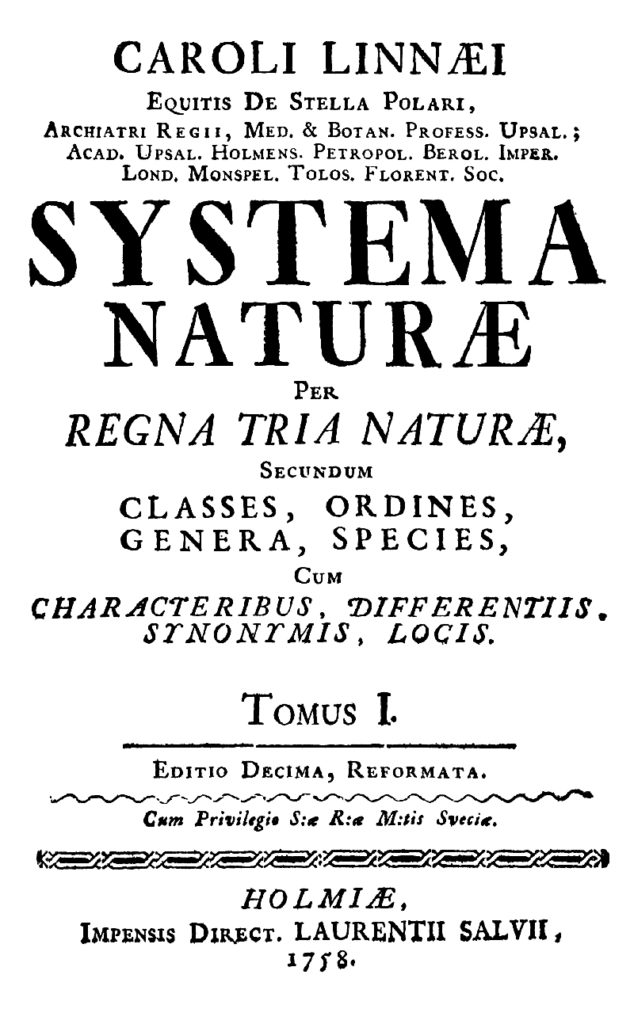Systema Naturae was the manuscript published by Carl Linnaeus that marked the beginning of the modern system of species classification by establishing a hierarchical naming system for organisms. This manuscript was originally published in 1735 and began as a small twelve page book. Over the decades subsequent editions were published, twelve in all, with the last one being published in three volumes and consisting of over 2,400 pages.
Earlier Attempts at a Classification System of Life
The Greek philosopher Aristotle was the first to attempt to classify life in his History of Animals. He chose to classify life according to its similarities in the form of a ladder-like hierarchy. He regarded species as fixed and unchanged. Medieval scholars, guided by Aristotle and the Bible, built on this idea creating The Great Chain of Being. This classification system arranged the universe according to its natural order as decreed by God. Those of the simplest order such as minerals were placed at the bottom, and that of the highest order which was God is seated at the top. Consequently, this scale of natural order was borrowed by medieval rulers to justify slavery while helping to create and maintain a socially rigid hierarchy consisting of kings, nobles, vassals, peasants, and slaves.
During the Renaissance scientists began experimenting on different classification systems. The discovery of new species of plants and animals in the New World, Africa, and Asia prompted excitement from scientists who were eager to place them into existing classification systems. But this also lead to a reanimation of the existing systems and encourages exploring with new and different systems.
Carl Linnaeus and the Classification of Species
Carl Linnaeus, later known as Carl von Linne, was born in southern Sweden to into a modest family where he became interested in plants form an early age. He was unique among scientists in this age in that his name went from a Latinized form to one of the vernacular, and this probably speaks to the high opinion of himself that he held throughout his life. After completing his medical studies he became intrigued by the idea that plants reproduce sexually through male and female parts corresponding to those of animals, although it seems he never fully understood the role of insects in pollination.
While on an expedition to the Netherlands in 1735 and still a student he published his ideas on taxonomy called Systema Naturae. This work went through many subsequent editions and quickly grew in volume. This first edition only included plants, his later editions included both plants and animals.
The tenth edition, published in 1758, is widely considered as the starting point for modern zoological nomenclature. Throughout this edition Linnaeus used binomial nomenclature for all species – both plants and animals whereas in previous editions he had only used binomial nomenclature for plants. He was not the first person to use binomial nomenclature for life, Aristotle used it in his classification system but did not do so methodically.
The data accumulated throughout his various publications was immense. He provided names and descriptions for over 4400 species of animals and 7700 species of plants, mostly all of the species known by Europeans at the time. Everything in the living world was placed in a hierarchy of relationships. The hierarchy began with broad categories such as Kingdom and Class and moved down the ranks to the Genus and Species. Linnaeus took the bold step of placing man into his system of biological classification system with the Primates, a controversial move at the time. Despite this move Linnaeus still very clearly a religious man who considered man to be a special creation of God.
The Impact of Systema Naturae
It is had to overstate the influence of this book and its author. Linnaeus’s system immediately proved useful and was soon quickly adopted by others. One of its main benefits was that it was straightforward and clear. Prior to Linnaeus taxonomy was burdened by cumbersome and inconsistent names. Systema Naturae created a global system of naming and ranking organisms – a naming system that supersedes languages – that we continue to use to this day, with only some exceptions to the Linnaeus’ ranking system.
With this rise of evolutionary thought a century later classification became a tool to explain genealogical relationships. Charles Darwin’s Theory of Evolution rendered the old idea of Aristotelian natural order behind Linnaeus’s system invalid. He showed that evolution could produce a hierarchy of similarity based on common decent.
Continue reading more about the exciting history of science!
